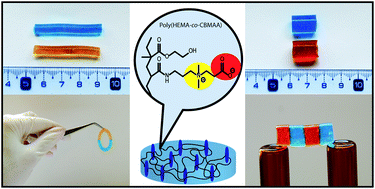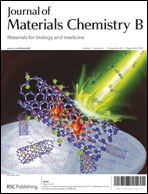Novel antifouling self-healing poly(carboxybetaine methacrylamide-co-HEMA) nanocomposite hydrogels with superior mechanical properties†
Abstract
Novel antifouling highly wettable hydrogels with superior mechanical and self-healing properties are presented. Hydrogels were prepared by UV-initiated copolymerisation of non-fouling zwitterionic carboxybetaine methacrylamide (CBMAA-3) and 2-hydroxyethyl methacrylate (HEMA) in the presence of uniformly dispersed clay nanoparticles (Laponite XLG) in water. The nanoparticles acted as physical cross-linkers resulting in excellent mechanical resistance. The effects of composition such as the amount of nanoclay and the HEMA/CBMAA-3 molar ratio on the physical properties of the nanocomposite hydrogels were investigated. These gels showed outstanding composition-dependent mechanical properties, exhibiting remarkably large elongations at break (≥1800%) and high strengths and moduli even at higher molar contents of CBMAA-3 and higher degrees of swelling (DS). Furthermore, these hydrogels were able to repair mechanical damage without the use of any healing agent by spontaneous reconstruction of cross-links across a damaged interface.


 Please wait while we load your content...
Please wait while we load your content...